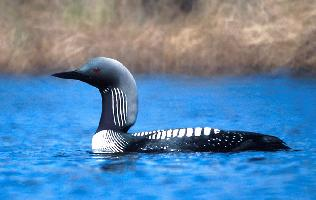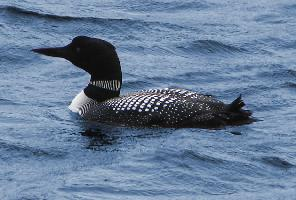
Descrierea animalului
The Pacific Loon, scientifically known as Gavia pacifica, is a captivating species of bird that graces the northern waters with its presence. A member of the loon family, this species is admired for its distinctive appearance and mesmerizing vocalizations, making it a subject of interest among birdwatchers and nature enthusiasts alike.Physically, the Pacific Loon is a medium-sized bird, with adults typically measuring between 58 to 74 cm in length and weighing around 1 to 2.5 kg. Its body is streamlined, an adaptation for its aquatic lifestyle, allowing it to dive and swim with remarkable agility. The neck is relatively long, supporting a rounded head, and the bill is straight and pointed, perfectly designed for catching fish.
The plumage of the Pacific Loon is particularly striking during the breeding season. The head and neck shimmer with an iridescent greenish-blue sheen, while the throat is adorned with a distinctive black and white striped pattern. The back is speckled with white spots against a dark background, and the chest and underparts are primarily white. This bold and contrasting plumage not only serves as a visual signal to potential mates but also provides camouflage against predators when the bird is on the water.
Outside of the breeding season, the Pacific Loon adopts a more subdued appearance, with the vibrant breeding colors giving way to a predominantly grey and white plumage, making it less conspicuous in its winter marine environments.
Habitat-wise, the Pacific Loon breeds in the Arctic and subarctic regions, favoring freshwater lakes and ponds with clear water and abundant fish. It is during the breeding season that their haunting and melodious calls can be heard echoing across the still waters, a sound that adds to the mystique of the northern wilderness. In winter, these birds migrate to coastal waters, showing a preference for sheltered bays and estuaries along the Pacific coast, from Alaska down to Baja California in Mexico.
Dietarily, the Pacific Loon is a proficient hunter, diving beneath the water's surface to catch fish, crustaceans, and aquatic invertebrates. Its powerful legs, located towards the back of its body, propel it through water with ease, allowing it to pursue and capture its prey with precision.
Reproduction is a significant time for the Pacific Loon, with pairs forming monogamous relationships for the breeding season. Nests are constructed in sheltered locations near water, where the female lays typically two eggs. Both parents share the responsibility of incubation and feeding, demonstrating a strong commitment to their offspring's survival.
Despite facing threats from habitat destruction, pollution, and climate change, the Pacific Loon has maintained a stable population, thanks in part to conservation efforts and protected areas that safeguard its breeding and wintering habitats.
In summary, the Pacific Loon is a remarkable bird, embodying the wild and untamed beauty of the northern waters. Its striking appearance, intriguing behaviors, and haunting calls make it a fascinating subject for study and observation, and a symbol of the rich biodiversity that our planet has to offer.
Animale similare
Fotografii noi cu animale
Top 10 animale
- Dolphin gull (Leucophaeus scoresbii)
- Diana monkey (Cercopithecus diana)
- Moustached guenon (Cercopithecus cephus)
- Stone loach (Barbatula barbatula)
- Greek tortoise (Testudo graeca)
- Galápagos tortoise (Geochelone nigra complex)
- Japanese macaque (Macaca fuscata)
- Russian tortoise (Testudo horsfieldii)
- Common flying dragon (Draco volans)
- Galápagos penguin (Spheniscus mendiculus)
